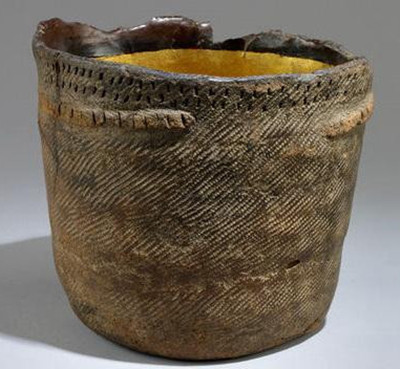It's pretty underwhelming to look at-in fact it's quite dull. It's made of brown-grey clay, a simple round pot about the size of the bucket that children play with on the beach, about six inches high, six inches across at the top, and its got it's got straight sides and a flat base, and it was made about seven thousand years ago in Japan.
其实它本身令人印象相当之深刻。虽然它颜色其实很暗淡,原料是棕灰色的粘土,简简单单的圆型深钵,大小就像孩子们用在沙滩上玩耍的那种小塑料桶一样,大概六英寸高,上边端口直径也差不多六英寸,两侧是笔直的直线,还有一个平底。它大概是制造于七千年前的日本。
When you look more closely, you can see that it was built up with coils of clay and then, into the outside, fibres have been pressed, so that when you hold it, you feel as though you are actually holding a basket. It looks and feels like a basket in clay.
当你再仔细一点观察,你就可以发现它其实是用一圈圈的粘土圈先绕成型的,然后外边压上绳索般的花纹。当你拿起它的时候,就感觉像是在举着一个篮子。其实它看起来就像一个粘土制成的篮子。
The basket - like markings on this and other Japanese pots of the same time, are in a cord pattern and that's in fact what their name is in Japanese. They are Jomon - or 'cord-pattern' pots.
这种仿照竹篮纹理的花纹,在这件陶器及其同时期日本陶罐上都可以找到,被人们称之为绳纹,事实上它们的命名在日文里就是这意思。它们就是绳纹陶器。
And the word Jomon has come to be used not just for the objects, but for the people that made them, and even the whole historic period in which they were lived. It was the Jomon people living in what is now northern Japan, who created the world's first pots. Simon Kaner, of the University of East Anglia, is a specialist in ancient Japanese culture:
现在绳纹一词,已经不仅仅是这些物品的名称,那时代的人类,及他们生活的整个历史时期都被称之为绳纹。正是这些生活在如今日本北部的绳纹人制造了世界上的首件陶器。东英吉利大学的西蒙?康尔是古日本文化的专家,他说道:
'In Europe we've always assumed that people who've made pottery were farmers, and that it was only through farming that people were able to stay in one place, because they'd be able to build up a surplus that they could then subsist on through the winter months, and it was only if you were going to stay in one place all the year round, that you'd be making pottery, because it's an awkward thing to carry around with you.
“在欧洲,我们一向认为制作陶器的古人类肯定是农耕人类,因为只有依靠农业,人类才能定居下来,他们可以长年停留在同一地方,渐渐积蓄起余粮,培养起一种可持续的生活方式,能保证他们顺利渡过寒冬里那几个月。而且只有长年居住在同一地方,才有制作陶器的必要,要不然如果你得东奔西跑,这种东西搬来搬去可真是不方便。”
'The Japanese example is really interesting, because what we have here is pottery being made by people who were not farmers, and it's one of the best examples that we've got from anywhere in the world really - from pre-history, of people who subsisted on fishing, gathering nuts and other wild resources, and hunting wild animals - that they also had a need for cooking pots.'
“日本这例子真是相当有趣。因为这些陶器不是农民做出来的。这绝对是我们在全世界范围内收集到的关于史前文化的最好例子。这些人类捕鱼、采集坚果及其他野生植物,同时也狩猎野生动物,同时他们也需要煮东西的盆钵锅罐。”












